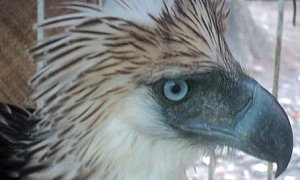Philippine Eagle
abounds in the rich forests of Taft, Eastern Samar
By Philippine Information
Agency (PIA 8)
March 16, 2013
TACLOBAN CITY – The
ecologically important bird species, the Philippine Eagle with the
scientific name of Pithecophaga Jefferyi naturally inhabits the rich
forests of Samar.
 The recent citing of the
Philippine Eagle at the Taft Forest Wildlife (Philippine Eagle)
Sanctuary confirmed this, Department of Environment and Natural
Resources Regional Executive Director Manolito Ragub informed.
The recent citing of the
Philippine Eagle at the Taft Forest Wildlife (Philippine Eagle)
Sanctuary confirmed this, Department of Environment and Natural
Resources Regional Executive Director Manolito Ragub informed.
“The sighting of the
Philippine Eagle is something which the people of Eastern Visayas must
be proud of,” RED Ragub said. It is in this part of the country where
this important bird species naturally abound.
The presence of the
Philippine Eagle is an indicator that there is still an
ecologically-balanced forest in Samar, RED Ragub informed.
He added that while the
government is spending so much money just to propagate this species in
captive breeding like what is being done by the Philippine Eagle
Foundation Center in Davao, Eastern Visayas has its own naturally
breeding Eagles in the forests of Samar.
The Taft Forest Wildlife¸
the Philippine Eagle¸ was sighted on March 10, 2013 in the forests of
San Rafael, Taft, Eastern Samar which is part of the Philippine Eagle
Sanctuary, Samar Island Natural Park Protected Area Superintendent
Angelito Villanueva informed RED Ragub in a report.
The Philippine Eagle was
sighted in the by Ms. Ruth Francisco, a member of the Wild Bird Club
of the Philippines in the course of her birding activity. Together
with Ms. Francisco was Mr. Joselito Sierra, a local tour guide of the
SINP.
Ms. Francisco who has been
conducting birding activities for two years already, has been to
different forested areas in the country like the Mt. Kitanglad in
Bukidnon.
Francisco said that she
usually sees wild birds in flight and the Philippine Eagle in
captivity.
At the Taft Philippine Eagle
Sanctuary, however, she actually sighted a Philippine Eagle in the
wild just about 100 meters away from her standpoint.
Ms. Francisco was on her
second visit to the SINP to look for the Mindanao Bleeding Heart, a
species of bird in the pigeon and dove family (Columbidae) so named
because of a red blotch on its breast, which is endemic to the
Philippines.
At 7:55 in the morning of
March 10, “While hiking amidst the forest on a cloudy with occasional
rains morning, we heard the call of a Rufus Hornbill,” Ms. Francisco
excitedly shared to DENR Region 8 Regional Public Affairs Officer
Purificacion Daloos.
“Expecting that the Mindanao
Bleeding Heart will follow, I positioned my camera and was excited to
see a raptor… the Philippine Eagle,” Ms. Francisco narrated.
“The Philippine Eagle was
preening while perching for about five minutes, on a leafless tree on
top of a cliff. It stayed there until three Rufus Hornbills flew in
and perched on a nearby tree. Disturbed by the noise of the Hornbills,
the Philippine Eagle flew away,” Ms. Francisco recounted.
She added that other birds
seen in the thickly forested area with surrounding perching trees were
two Samar Hornbill, two Yellowish Bulbul, one Amethyst Brown Dove,
four Red-keeled Flowerpecker, four Orange-bellied Flowerpecker, two
Philippine Bulbul, and one Sunpride Species.
RED Ragub said the sighting
of the Philippine Eagle is not only a moment of pride and rejoicing,
but more so, a challenge and reminder to every Filipino especially the
people of Samar to help protect the remaining forest of Samar.
The continued existence of
the Philippine Eagle and other wildlife species depends on the
condition of the forest, their habitat, RED Ragub said.
The Philippine Eagle was
first sighted in Paranas, Samar on June 15, 1896 by a British
collector John Whitehead. The various sightings of the Philippine
Eagle in the forests of Samar prompted then President Joseph Estrada
to declare on July 31, 1999, the 3,720 hectares of the said forests as
Taft Forest Wildlife (Philippine Eagle) Sanctuary through Presidential
Proclamation No. 155.